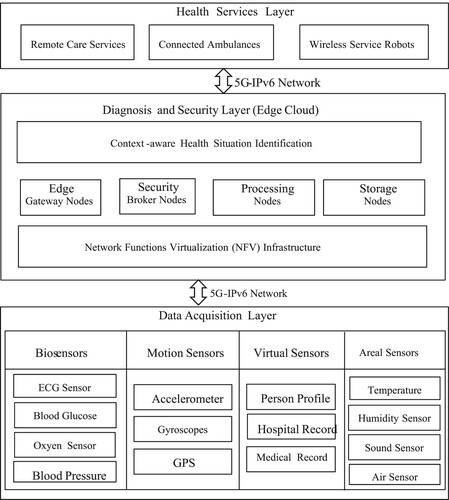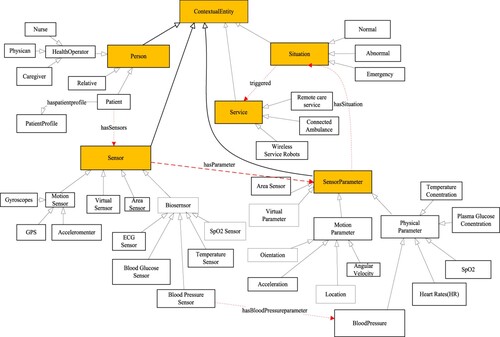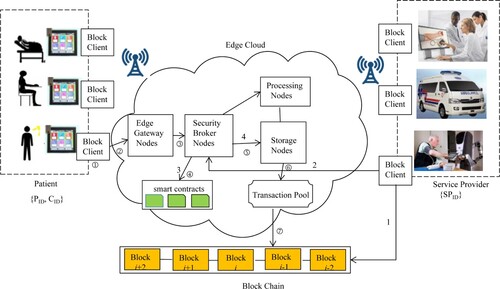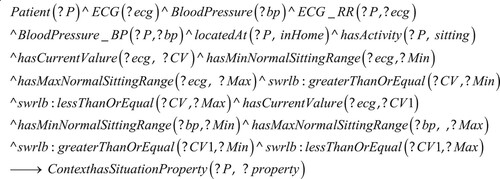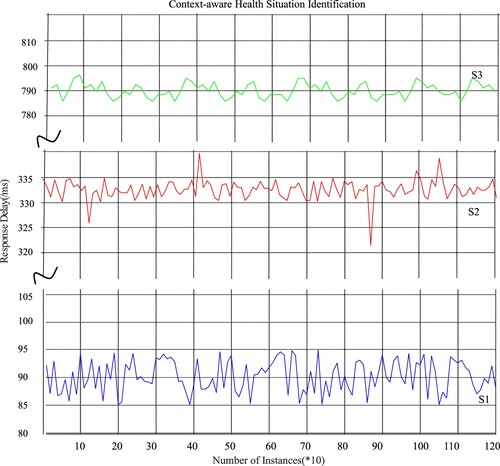 ?Mathematical formulae have been encoded as MathML and are displayed in this HTML version using MathJax in order to improve their display. Uncheck the box to turn MathJax off. This feature requires Javascript. Click on a formula to zoom.
?Mathematical formulae have been encoded as MathML and are displayed in this HTML version using MathJax in order to improve their display. Uncheck the box to turn MathJax off. This feature requires Javascript. Click on a formula to zoom.Abstract
Currently, the main challenges of the frameworks for healthcare monitoring are as follows: minimising latency, especially for delay-sensitive diseases such as sudden heart disease; identifying health situation in a timely and accurate manner when correlating physiological indicators and context information; reducing the risk of exposure because health data are highly private. In response to the above, this paper proposes a framework for 5G-secure-smart healthcare monitoring (5GSS) to achieve the following goals: fast and accurate identification of context-aware health situation, blockchain-based secure data sharing, and low-latency services for emergent patients. The framework consists of a data acquisition layer, a diagnosis and security layer (edge cloud), and a health service layer. The proposed framework adopts the following key technologies: a 5G-IPv6 communication network, context-aware health situation identification-based similarity measure, and blockchain-based secure data sharing mechanism. Finally, a prototype system has been implemented to monitor hypertensive heart disease, confirming its effectiveness with respect to a real scenario. Combined with the data of 45 patients, the prototype system can identify health situations with an accuracy of 96.34% at a sensitivity of 92.46% and a specificity of 93.62%, while significantly reducing the latency and improving the data sharing security.
1. Introduction
The number of patients with cardiovascular disease (CVD) is on the rise all over the world. According to 2019 World Health Statistics, 17.9 million people died due to CVD in 2016 (World Health Organization, Citation2019). In China, there were an estimated 290 million of CVD patients in 2016 and the CVD mortality rate is on the rise in both rural areas and urban areas. Healthcare monitoring is considered as a promising solution to addressing the challenge of continuous observations of CVD. It is used to evaluate the health conditions of elderly people and the patients in smart environments (Mshali et al., Citation2018). The results of numerous studies have shown that subtle signs of acute CVD can be monitored, and effective measures can be taken to respond to emergency situations in advance.
Recently, the healthcare monitoring framework is receiving widespread attention. Cloud-based healthcare monitoring framework consists of a Wireless Body Area Network (WBAN), a Gateway (GW) and a Cloud platform (Hameed et al., Citation2016; Verma & Sood, Citation2018a). Compared with Cloud computing, the edge computing (Fog computing) paradigm offers local storage, local data mining and can efficiently reduce latency, which has profound impacts on healthcare monitoring (Rahmani et al., Citation2018). In recent years, there are some efforts of edge computing (fog computing) in healthcare monitoring. A fog-assisted gateway was proposed for the remote patient health monitoring in smart homes (Verma & Sood, Citation2018b). A wearable sensor-based system was proposed for activity prediction using a Recurrent Neural Network (RNN) on an edge device (Uddin, Citation2019). A healthcare system was proposed to detect and process physical data using cognitive computing at the edge of the network (Chen et al., Citation2017; Chen et al., Citation2018). An Internet Protocol Version 6 (IPv6)-based framework for fog-assisted healthcare monitoring was proposed (Hu et al., Citation2019). A secure framework of healthcare monitoring was proposed, which integrated Named Data Networking-based IoT with edge cloud. The framework could not only improve the efficiency of medical data retrieval but also utilise cipher text and signatures to support the security of medical data transmission (Wang & Cai, Citation2020). The above works neglected the further optimisation of response time and latency in real-time fog environment. In summary, the main challenges facing the frameworks for healthcare monitoring are as follows: minimising latency, especially for delay-sensitive diseases such as sudden heart disease; identifying health situations in a timely and accurate manner when correlating physiological indicators and context information; reducing the risk of exposure because health data are highly private.
1.1. Related works and motivation
To solve the aforementioned problems, more technical innovations should be taken into consideration in healthcare monitoring. The characteristics of these technologies are as follows:
5G communication network allows extremely fast response time. Chen et al. proposed a 5G Cognitive System (5G-Csys)-based healthcare system, which consists of two parts, namely the resource cognitive engine and the data cognitive engine (Chen et al., Citation2017). Based on 5G tactile Internet and SDN, the resource cognitive engine guarantees ultra-low latency and ultra-high reliability of the system (He et al., Citation2021). Based on machine learning and deep learning, data cognitive engine identifies the health situation from physiological and psychological perspective. In addition, IPv6 provides the end-to-end transmission across multiple IP networks. The combination of IPv6 and 5G mobile communication networks will bring some opportunities, such as mobility and security for 5G networks (Al-Turjman, Citation2019). Mobile devices or wearable sensors can actively benefit from mobile IPv6 implementation, to realise the communication between the two isolated networks. Berguiga et al. (Citation2021) proposed a Fast handover Proxy Mobile IPv6 for Sensor networks (FPMIPv6-S). When a sensor moves from one Personal Area Network (PAN) to another, FPMIPv6-S supports the network-based mobility.
Context-aware computing allows identifying behavioural patterns and making precise inferences about the monitored subject’s condition and environment (Mshali et al., Citation2018). Esposito et al. (Citation2018) proposed a smart mobile, self-configuring, context-aware architecture for different healthcare monitoring applications. The architecture included sensing layer, perceptual layer, reasoning layer and actuating layer. Zhang et al. (Citation2017) proposed an ontology-based framework for follow-up assessments of chronic disease patients. The framework integrated medical domain knowledge, patient data and patient assessment criteria.
Blockchain is a singleton machine for secure transaction with a shared-state, which provides a trusted channel for data exchange. Due to its advantages, such as decentralisation, tamper resistance and network data sharing, blockchain has the great potential in data protection of healthcare monitoring (Tandon et al., Citation2020). Zhou et al. (Citation2019) proposed a model called Med-PPPHIS to manage health data and form a medical data chained protection mechanism. Dwivedi et al. (Citation2019) proposed a modified blockchain suitable for IoT sensors and devices to provide secure data management. The modified blockchain eliminated the concept of Proof of Work and relied on their additional security properties based on advance cryptographic primitives of the network (Li et al., Citation2021; Liang et al., Citation2021). Tuli et al. (Citation2019) proposed a simplified and blockchain-based framework for integrating IoT, Edge, Fog and Cloud. Blockchain-based smart contracts were used to manage and protect health data generated by medical sensors (Griggs et al., Citation2018; Zhang et al., Citation2020).
The relevant enlightenments are drawn from the above-mentioned solutions as follows: (i) The combination of 5G and IPv6 should further reduce communication latency and enhance mobility support for wearable sensors. However, a few works integrate edge computing, 5G and IPv6 for healthcare monitoring. (ii) It is difficult to meet the requirements of low-latency applications for context-aware healthcare monitoring systems, because the ontology-based precision reasoning requires a lot of time. In addition, follow-up assessments of CVD have been neglected. (iii) Healthcare monitoring causes privacy risks and security issues; blockchain is suitable for the patients and the health service providers to provide secure data sharing in 5G and edge computing environments.
1.2. Objective and key contributions
This paper presents a framework for 5G-secure-smart healthcare monitoring (5GSS) to achieve the following goals: fast and accurate identification of context-aware health situation, blockchain-based secure data sharing mechanism, and low-latency services for emergent patients. This framework is a composite of a data acquisition layer, a diagnosis and security layer (edge cloud), and a health service layer. The data acquisition layer performs data retrieval from sensors directly or indirectly in a smart environment. Edge cloud performs context-aware health situation identification and utilises blockchain-based secure data sharing mechanism to facilitate secure uploading and sharing of health data. The health service layer supports a variety of advanced healthcare services.
The key contributions of our work are as follows:
A 5G-IPv6 network architecture is proposed for further reducing latency and enhancing mobility support for wearable sensors. Furthermore, it is suitable for dynamic sensors and reliable for advanced health services.
Health situation identification, based on similarity measure, is proposed for better reducing response time than ontology reasoning. The best values of weights in similarity measure can be obtained by Multi-Layer Perceptron (MLP) combined with batch normalisation, which removes the dependence on manually set weights.
Blockchain-based securing data sharing mechanism is proposed for achieving secure sharing of health data among the patients and the health service providers.
1.3. Organisations
This paper is organised as follows. The 5G-Secure-smart healthcare monitoring framework is proposed in Section 2. Section 3 discusses some key technologies of the proposed framework. The prototype system for monitoring hypertensive heart disease and performance evaluation are depicted in Section 4. Finally, section 5 draws the conclusions and discusses the future work.
2. Proposed framework
The proposed framework is designed for collecting, processing and storing patient’s physiological parameters and context information, and for supporting context-aware health situation. In cases where emergency situations are discovered, advance health services are triggered. Wearable sensors of the patient connect edge cloud through 5G-IPv6 communication network, and Blockchain ensures sharing of health data between the patients and health service providers. Figure illustrates the functional model of monitoring applications that can be built on the basis of the proposed framework. The framework can provide a generic set of features to guide the concrete realisation of healthcare monitoring applications for a variety of possible scenarios.
Figure 1. The functional model of monitoring applications that can be built on the basis of the proposed framework.
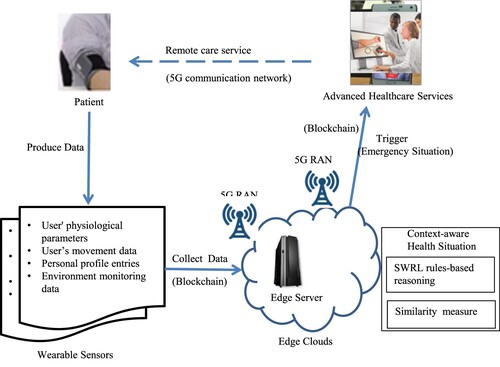
The proposed framework comprises a data acquisition layer, the edge cloud, and a health service layer. The interaction between the layers is based on the 5G-IPv6 communication network. The hierarchical framework of healthcare monitoring is shown as Figure .
Data acquisition layer
This layer collects data directly or indirectly from different sensors in a smart environment. Sensor data are obtained either continuously or periodically, and then the layer transfers it to the edge cloud for analysis and diagnosis. In practice, biosensors, motion sensors, and area sensors usually use the direct method to obtain data from sensors, while virtual sensors use the indirect method to obtain data. Biosensors monitor the patient’s physiological parameters in real time. Motion sensors, such as accelerometer sensors, gyroscopes and GPS, are used to monitor movements including walking, standing and sitting. Virtual sensors include software services capable of collecting personal profile entries, medical records and hospital records. Area sensors are used to collect context data of the patients’ surrounding environments. Different sensors can be optionally customised to obtain the required physiological data and context information according to specific demands. Single sensor or a set of sensors can be considered as 6LoWPAN Mobile Node of 5G-IPv6 network.
Diagnosis and security layer (Edge cloud)
Edge cloud is a key component for smart healthcare monitoring. It consists of edge gateway nodes, security broker nodes, processing nodes and storage nodes. Each gateway node acts as a gateway (Sensor Mobile Access Gateway) and supports switching from short-range protocols to IPv6. In addition, the data collection from different sensors takes place at the gateway node, allowing continuous connection of different Proxy Mobile IPv6 (PMIPv6) domains of 5G networks. To ensure reliability while interacting with processing nodes, each security broker node works as a firewall of processing nodes and is equipped with adequate security features based on Ethereum platform (Buterin, Citation2016). Storage node manages distributed database to facilitate secure storage and data sharing. Processing node communicates with other processing nodes to execute context-aware health situation identification. The main works of edge cloud are as follows:
Once the heterogeneous sensors have connected the edge cloud through the 5G-IPv6 communication network, the edge cloud will identify them and then perform context-aware data fusion (Yu et al., Citation2020).
The similarity measure of situations indicates the possibility of a certain situation compared to a reference situation (e.g. an emergency situation). Based on the similarity measure, context-aware health situation identification can also give an opportunity to determine the possible cause-and-effect relationship of these findings (i.e. follow-up assessments) and take appropriate actions.
Blockchain-based secure data sharing mechanism uses smart contracts to secure sharing of health data between the patients and health service providers. In this mechanism, Ethereum platform is selected as a blockchain platform, which contains blocks for smart contracts and data transactions.
Health service layer
Health service layer provides a variety of advanced healthcare services, such as remote care services, wireless 5G-connected smart ambulances and wireless service robots. Health services are critical to the emergency situation of CVD, such as sudden heart disease and paroxysmal hypertension. Therefore, health services may require responsiveness, high reliability and low latency (Xu et al., Citation2021).
3. Key technologies of the proposed framework
3.1. A 5G-IPv6 network architecture
5G can meet most of the requirements for smart health monitoring, such as high bandwidth, ultra-high reliability communications and ultra-low latency. We propose a 5G-IPv6 network architecture and its mobility management scheme. The proposed network architecture should bring many advantages for healthcare monitoring, such as lower communication latency and better support for the mobility of wearable sensors.
5G-IPv6 network architecture
In this architecture, sensors and advanced health services can be connected to the edge cloud through 5G RANs (Radio Access Networks). 5G RAN includes a distributed unit and a central unit, which has a bottom–top protocol stack: Radio Frequency, PHY, MAC, Radio Link Control, and Packet Data Convergence Protocol. Additionally, 5G RANs support a wide range of spectrum bands. SDN and Network Functions Virtualisation Infrastructure (NFV) are important driving forces for 5G network to edge computing. SDN can divide a network into control plane and data plane to improve network flexibility and agility, which helps to deploy new services and simplify network management. As a consequence, 5G SDN is suitable for dynamic sensors and reliable nature of advanced health services. Moreover, NFV performs network functions in virtual machines on edge servers, which can provide flexible and scalable networks to process large amounts of physical data and context information. Context-aware data fusion and health situation identification are constructed in the form of VFVs, which can run as virtual machines. Through SDN and NFV infrastructure, the 5G-IPv6 network architecture (see Figure ) shows very good flexibility, cost-efficiency, and scalability.
Mobility management scheme
IETF (Internet Engineering Task Force) has developed PMIPv6 as a network-based mobility management protocol, but it can only support homogeneous handover (Taleb et al., Citation2017). Different sensors of healthcare monitoring are heterogeneous, which bring about some problems for PMIPv6. In the mobility management scheme of 5G-IPv6 architecture, we adopt the bottom–top protocol stack to support switching from short-range protocols to IPv6.
6LoWPAN Mobile Node
The 6LoWPAN Mobile Node can be a signal node or a group sensor node. In addition to the wide-range protocol used to virtual sensors built-in mobile intelligent terminals, most heterogeneous sensors usually utilise short-range wireless technologies (e.g. ZigBee, Bluetooth). For example, to support IPv6, Bluetooth 5 uses the following bottom–top protocol stack: PHY, LL, HCI, L2CAP, 6LowPAN, μIPv6.
Sensor Mobile Access Gateway
The edge cloud is composed of edge servers. Edge server node in the edge cloud acts as Sensor Mobile Access Gateway (SMAG). Packets were sent from 6LoWPAN Mobile Node to Sensor Local mobility Agent through SMAG. Each edge server node takes a built-in unified gateway as a boundary and supports switching from short-range protocols to IPv6, which allows 6LoWPAN Mobile Nodes to connect. Each 6LoWPAN Mobile Node sensor has a unique IPv6 128-bit long address, which is automatically configured by a global routing prefix, a subnet identifier, and an interface identifier. When 6LoWPAN Mobile Node moves from SMAG to another, it was always identified by its HoA (home address).
Domain Mobility Agent
When 6LoWPAN Mobile Node moves within a PMIPv6 domain, Domain Mobility Agent (DMA) is responsible to provide continuous connections and uninterrupted service. Moreover, DMA provides mobility support for 6LoWPAN Mobile Node when it moves from one PMIPv6 domain to another.
The proposed network architecture meets communication continuity when the patient carries them from one location to another. Besides 5G SDN and NFV, it also provides flexible, automated, and scalable networks of virtual machines to support context-aware situation identification.
3.2. Context-aware health situation identification
Context ontology should avoid grammatical heterogeneity and semantic heterogeneity of sensors’ data, making it easier to identify health situations. Based on context ontology, we design two context-aware health situation identification algorithms, namely, SWRL rules-based reasoning and similarity measure.
Context ontology
Figure shows the structure of context ontology. Person, Sensor, SensorParameter, Service and Situation are entities which specialise in different concepts depending on the context subdomain they belong to. In detail, Person can be patients, relatives and health operators. Sensor can be of different types as well, including biosensors, virtual sensors, motion sensors, and area sensors. Service can be of advanced health services. The situation depends on physiological signal and context information. Each type of sensor can contain several situations. Each situation has data-type properties, such as a type, a max value and a min value, which are defined by experts in the CVD field. These situations are divided into three categories: emergency, abnormal and normal.
SWRL rules-based reasoning
SWRL rules-based reasoning plays an important role in emergency situation identification. Inference rules are formulated in SWRL to express all required statements. SWRL rules can be dynamically activated, depending on the specific subject in the monitoring application. The edge cloud maintains a set of declarative rules, and ensures the correct flow of inference execution and infers the respective situation of the patient (See Algorithm 1).
Table
Similarity measure
Similarity measure is calculated by the similarity between current situation instances reported by the healthcare monitoring system and reference situation. Reference situation refers to an abnormal situation or emergency situation. In cases where abnormal signs are discovered (i.e. semantic similarity exceeds the threshold), advanced health services are triggered. The formula of similarity measure of the situation is as follows:
(1)
(1) where
is the similarity between each concept of
and
including taxonomy-based similarity and feature-based concept similarity,
is the number of common concepts of
and
,
is the number of concepts of
but not existing in
.
,
is the current situation
and reference situation
of a patient, respectively,
is the weight value which refers to the importance of the
atomic similarity,
,
,
,
.
Taxonomy-based concept similarity
Taxonomy-based concept similarity focuses on the relationship, instead of distinguishing the complex binary relationship between concepts. It uses dynamic weights to improve calculation flexibility.
Definition 1 The dynamic weight value of concepts is defined as
(2)
(2) where
is a predefined factor,
,
is the longest path length from the root concept of taxonomy
to concept
.
The process for calculating taxonomy-based similarity is as follows:
Step1. Merging health situation and current situation
to form a single ontology
, only considering the
relations and extracting concepts from ontology
to establish the taxonomy
;
Step 2. Let and
be two concepts of taxonomy
, the formula of
is as follows.
(3)
(3) where
is the weighted distance of concept
and
, and its formula is
(4)
(4) where
denotes the closest common parent of
and
,
,
and
are the weight values of concepts
,
and
, respectively,
is the closest common parent of
and
.
Feature-based concept similarity
The process for calculating feature-based similarity is as follows:
Step 1. The concept features of current situation and reference situation are divided into text type and interval type.
Step 2. For text type features, establishing the feature vectors, where common features’ positions of and
are recorded as 1, other positions are recorded as 0, then the calculation formula of text-based feature similarity is as follows:
(5)
(5)
(6)
(6) where
,
are the corresponding
,
feature vector,
is the unit vector,
is the weight,
,
are concept depths of
,
, respectively.
Step 3. For interval type features, supposing that there are two intervals ,
, where
are sorted from largest to smallest as
, then the calculation formula of interval type feature similarity is as follows:
(7)
(7) where
is a symbolic function.
Step 4. By calculating the linear weighted sum of text type feature similarity and interval type attribute similarity, a feature-based concept similarity between the concept of situation and
is obtained, and the calculation formula is given as
(8)
(8) where
,
,
are text type feature and interval type feature coefficients, respectively.
Dynamic weight-based hybrid similarity
Taxonomy-based concept similarity ignores the valuable information of concept features, while feature-based concept similarity completely ignores the structural semantics of ontology. A dynamic weight-based hybrid similarity takes advantages of the taxonomy structure and features of concept of and
(9)
(9) Among them,
,
are the weights of
and
. In practice, the best values of
and
can be obtained by MLP combined with batch normalisation (called MLP + BN). BN can reduce the bias effect, speed up the training process and improve the generalisation of MLP.
is the output,
,
are the reconstruction parameters of the ith neuron in the lth layer after BN operation, which is governed by
(10)
(10) The output of the hidden layer combined with batch normalisation is
(11)
(11)
(12)
(12) where
is the output,
,
are the reconstruction parameters,
is the mini-batch mean,
is the mini-batch mean variance,
is a constant;
is the input,
is the corresponding weight of the input,
is a step function.
3.3. Blockchain-based secure data sharing mechanism
The edge cloud consists of edge gateway nodes, security broker nodes, processing nodes and storage nodes. Once wearable sensors have connected the edge cloud through the established 5G communication network, the edge cloud collects physiological signal and context information, and stores them in storage nodes for sharing with different health service providers. Security broker node serves as the entrance to Blockchain which ensures the integrity of exchanging health data with the patients and health service providers. Each patient has his own patient ID (PID) and context information ID (CID). Assume only {PID, CID} is kept on blockchain because large physiological signal and context information are stored in the edge cloud. As a consequence, a health service provider (SPID) should know the patients’ addresses {PID, CID}. The secure data sharing mechanism depends on smart contracts and blockchain of the Ethereum platform. Health service provider first creates an Ethereum account via Web3.js and then communicates with blockchain network to access health data (Leal et al., Citation2020; Xie et al., Citation2021).
The process of the patient (PID) uploading health data (See Figure ) is as follows:
Step . PID sends a request as a new transaction to upload data to the edge cloud and the corresponding blockchain client starts.
Step . The blockchain client of PID processes and sends the request to edge gateway node of the edge cloud.
Step . The edge gateway node forwards the request to the security broker node and smart contracts need to be verified.
Step . Through smart contracts with consensus protocol, the security broker node verifies the request. After accepting the request, the response will be returned to the edge gateway node, and allow PID to upload health data.
Step . The gateway node will use public key (PK) to encrypt health data. The gateway uploads these encrypted data to storage nodes on the edge cloud.
Step : Storage node receives and stores the health data which are recorded as {PID, CID} and returns a hash value.
Step : The uploading transactions are added to the transactions pool and packaged into a timestamped block through the mining process.
The process of service provider (SPID) retrieves health data as follows:
Step 1. SPID joins the blockchain network, uses the request information to create a transaction and then uses the private key to sign it for health data on the edge cloud.
Step 2. SPID connects to the edge cloud and uses the block client to send a data access request to the security broker node.
Step 3. The security broker node will use smart contract to verify the access right of SPID. After confirming the access request, the storage node will process the request of retrieving data.
Step 4. The storage node uses an asymmetric encryption algorithm to decrypt such requested data and finally returns the requested data to SPID.
4. Experiments and comparisons
4.1. Prototype system
We built the prototype system on the top of the proposed framework. The system includes Edge servers, Biosensors, Motion sensors, mobile intelligent terminal (virtual sensors), and area sensors. Area sensors are fixed at the top, middle and back corners of the room. The edge cloud has a certain number of edge servers. The main components of the system are as follows:
The system collects data directly or indirectly from different sensors in smart environment. Each sensor node integrates a wireless transceiver, a storage unit, data conversion, and other functional modules. Taking the biosensor as an example, it is mainly responsible for collecting physiological data, including heart rate, ECG, blood pressure, blood oxygen, breathing frequency, and other physiological parameters. Area sensors are used to collect context data of the patients’ surrounding environments. For example, DHT22, SNS-MQ2 and BMP280 were used to collect humidity, temperature and air quality levels, respectively.
Some edge servers act as gateways and support switching from short-range protocols to IPv6. In the implementation, an edge server can use a Cortex-A8 processor, a solid state hard disc, a multisensory-fusion-gateway, Xen VMM, and comply with IEEE 802.11a/802.11n/802.ac Standard.
Mobile intelligent terminal connects the nearest edge server with 5G Wi-Fi, because Wi-Fi access points (APs) are widely deployed. Beyond time and location, a tri-axial accelerometer was embedded in mobile intelligent terminal to help to monitor movements and body postures such as standing, sitting and walking. The device profiles evolve according to different contexts which can improve the applicability of the prototype system. Figure shows the interface display of mobile intelligent terminal for continuous monitoring of the patient’s health.
Figure 6. Screenshots of the prototype system in smart home environment: (a) wearable sensors are being equipped, (b) ECG monitoring, (c) blood pressure monitoring.
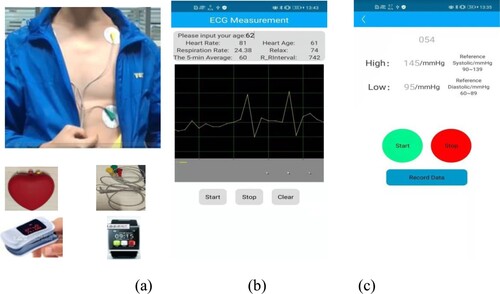
The proposed framework exhibits its novelty in the way that it provides a productive framework to build the prototype system for real-life monitoring applications. In other words, the existing solutions are not completely adequate to address all the changes listed in Section 1. The appropriate 5G-IPv6 technologies, context-aware health situation identification based on the similarity measure, blockchain-based secure sharing mechanism for less latency and secure data sharing are adopted in the proposed framework. The relative comparison of the state-of-the-art approaches to smart healthcare monitoring systems or frameworks is given in Table .
Table 1. State-of-the-art approaches to smart healthcare monitoring systems.
4.2. A case for a real-life scenario
A patient enters into the smart home environment with a mobile intelligent terminal. For example, in his smart environment, the patient needs to check his ECG level, blood pressure level and environmental parameters to follow his health conditions. Combined with environmental parameters, the situation of “hypertensive heart disease” can be identified by referencing the average electrocardiogram (ECG) level and blood pressure level. When the prototype system detects emergency situations that represent heart rate (“Sinus tachycardia”, RRi<500 ms) and blood pressure (Blood Pressure>160mmHg), his mobile intelligent terminal receives alarm messages from the edge server as quickly as possible.
Health situation identification-based SWRL rules-based reasoning
The edge server receives the data of different sensors and then identifies emergency situations-based SWRL rules-based reasoning as follows: IF ContextEntity has a Situation “hypertensive heart disease” THEN Situation triggers remote care service WHERE Service is Provided To User. Remote care services provide seamless remote interaction (e.g. video and voice conversation) between the patients and doctors. Figure shows the exemplary rule for identifying the situation of “hypertensive heart disease”.
Health situation identification based on similarity measure
This method is performed by calculating semantic similarity between current situation instances obtained by the healthcare monitoring system and reference situation. For “hypertensive heart disease”, the system usually chooses “Stage II Hypertension” (Systolic 160–179mmHg, diastolic 90–99mmHg) and heart rate (“Sinus tachycardia”, RRi<500 ms) as reference situation. Through customising different similarity threshold of similarity measure of situation, the prototype system also provides personalised follow-up assessment. Higher similarity indicates a worse control of the disease.
MLP + BN is exploited to obtain the best weights of taxonomy-based concept similarity and feature-based concept similarity. It consists of an input layer, three hidden layers and an output layer. The numbers of neurons in hidden layers are 16, 32, and 8, respectively. The activation function of the hidden layer is the ReLU, and that of the output layer is Softplus which can further optimise the network performance. The data are divided into the training set and the test set according to the ratio of 9:1. Figure shows the accuracy and loss values of MLP and MPL + BN in the training set of Health situation. Figure (a) shows that the accuracy of the training set is much higher than that of the verification set. MLP has the problem of overfitting. The convergence speed of MPL + Dropout in Figure (b) is slower than that of MLP + BN, as shown in Figure (c). When the highest accuracy (96.44%) of health situation identification in Figure (c) based on similarity measure is achieved, the corresponding values are considered as the best weights .
Accuracy, sensitivity and specificity of context-aware health situation identification
Figure 8. Accuracy and loss values of MLP (a), MLP + Dropout (b), and MLP + BN (Batch Normalisation) in training set and validation set.
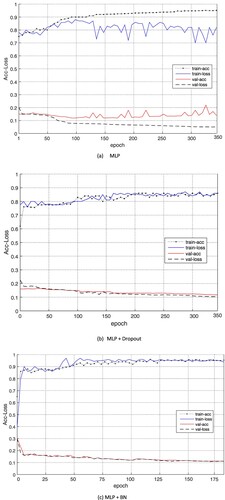
,
,
,
are true positive, true negative, false positive and false negative, respectively, and the calculation formulas are given as
(13)
(13)
(14)
(14)
(15)
(15)
Table shows the test results of situation identification. Combined with the data of 45 patients, for SWRL rules-based reasoning, accuracy over the sets identifies situation correctly 98.14% of instances. The sensitivity rate (89.32%) is lower than the specificity rate (93.53%). For similarity measure, accuracy over the sets allows to identify situation correctly 96.34% of instances. The sensitivity rate (92.46%) is lower than the specificity rate (93.62%). On the one hand, it is a positive feature of the prototype system, to some extent, as the edge cloud can void triggering unnecessary responses to call advanced services. On the other hand, the low sensitivity of SWRL rules-based reasoning indicates that the method can easily misdiagnose chronic patients as healthy persons. Health situation identification based on similarity measure has a high accuracy rate, sensitivity rate and specificity rate, which shows that it satisfies the various needs of disease diagnosis.
4.3. Performance evaluation and comparison
The performance of context-aware health situation identification
Table 2. The test results of situation identification based on SWRL rules-based reasoning vs. similar measure.
Table shows the approximate time required to execute context-aware health situation identification. The computation cost and communication cost of the proposed approach are compared with hybrid reasoning (Esposito et al., Citation2018), Recurrent Neural Network (RNN) (Uddin, Citation2019). Hybrid reasoning executes (wireless medium),
(data fusion),
(context extraction) and
(hybrid reasoning). RNN executes
(wireless medium),
(data fusion),
(feature extraction) and
(RNN). In the proposed approach, the patient executes
(5G environment),
(data fusion),
(context extraction) and
(SWRL rules-based reasoning) or
(similarity measure). Hybrid reasoning includes pattern matching and rule firing, and its complexity is better than SWRL rules-based reasoning. RNN requires a complicated training process, and its complexity is better than similarity measure. Obviously, the computation cost of our proposed approach is better.
Table 3. Relative comparison of computation cost of some recent state-of-the-art algorithms with the proposed approach.
We test the performance of similarity measure, SWRL rules-based reasoning and hybrid reasoning, as shown in Figure . The summarised test results are as follows:
Regardless of the cost of network transmission of health data, for the efficiency of data pre-processing of physiological data and context information, these three algorithms are similar.
The response-delay curve S1 of health situation identification on similarity measure is stable for about 90 ms. The response-delay curve S2 of SWRL rules-based reasoning and S3 of hybrid reasoning fluctuate at about 328 and 790 ms, respectively. This reflects the complexity of health situation identification, that is, SWRL rules-based reasoning, hybrid reasoning are more complicated than similarity measure.
We can be sure that the response delay of our proposed prototype is very low. By calculating the similarity measures between current situation and reference situation, the relations of abnormal situation and adverse events can be found in time.
The performance of data sharing mechanism
To evaluate the performance of the prototype system, we deploy an Ethereum platform on the edge cloud. The prototype system will allow authorised entities to access health data on the edge cloud, while preventing unauthorised entities from accessing health data. The user of mobile intelligent terminal creates an Ethereum account via Web3.js and communicates with blockchain network. We tested the performance of processing user requests under blockchain-based secure data sharing mechanism and non-blockchain mechanism, respectively (see Figure ).
Uploading health data
Figure 10. Time consumption of uploading health data (a) and health data retrieval (b) with respect to different health data file sizes.
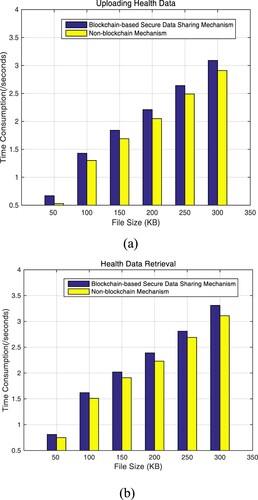
We measured time consumption for the edge cloud for uploading health data from the mobile intelligent terminal. Compared with the non-blockchain mechanism, this mechanism verifies the request through smart contracts with consensus protocol, which consumes more time to process user requests. In addition, the edge cloud can select health data and use public key to encrypt data. As the edge cloud is similar to complete the processing requests under two data sharing mechanisms, the average additional overhead of blockchain-based secure data sharing mechanism is only about 146 ms.
Health data retrieval
We measured the time consumption of access process, that is, from initiating an access data request to receiving the data of the edge cloud. The edge cloud verifies the access right of the doctor (i.e. the service provider) with a smart contract. The average of additional overhead of blockchain-based secure data sharing mechanism is only about 140 ms since the edge cloud is similar to complete the processing requests under blockchain-based secure data sharing mechanism and non-blockchain mechanism. The experimental result demonstrates the blockchain-based secure data sharing is relatively lightweight and responsive.
5. Conclusions
In this work, we have proposed a framework for 5G-secure-smart healthcare monitoring to achieve the following goals: fast and accurate identification of context-aware health situation, blockchain-based secure data sharing mechanism, and responsive and low-latency services for emergent patients. Some advantages of the proposed framework are as follows: (i) A 5G-IPv6 network architecture can reduce latency and enhance mobility support for wearable sensors. (ii) The framework quickly identifies health situation based on similarity measure in the edge cloud and triggers advanced health services to prevent and control cardiovascular disease. The best values of weights in similarity measure can be obtained by MLP + BN. (iii) A blockchain-based securing data sharing mechanism is used to achieve secure sharing health data among the patients and the health service providers. The next step is to further optimise Quality of Service parameters of context-aware health situation identification, especially in the presence of large-scale data collection. In the application, the framework can be made more robust in real-time edge environments.
Disclosure statement
No potential conflict of interest was reported by the author(s).
Additional information
Funding
References
- Al-Turjman, F. (2019). 5G-enabled devices and smart-spaces in social-IoT: An overview. Future Generation Computer Systems, 92, 732–744. https://doi.org/10.1016/j.future.2017.11.035
- Berguiga, A., Harchay, A., Massaoudi, A., & Youssef, H. (2021). FPMIPv6-S: A new network-based mobility management scheme for 6LoWPAN. Internet of Things, 13, 100045. https://doi.org/10.1016/j.iot.2019.02.005
- Buterin, V. (2016). Ethereum: Platform review. Opportunities and challenges for private and consortium blockchains.
- Chen, M., Li, W., Hao, Y., Qian, Y., & Humar, I. (2018). Edge cognitive computing based smart healthcare system. Future Generation Computer Systems, 86, 403–411. https://doi.org/10.1016/j.future.2018.03.054
- Chen, M., Yang, J., Hao, Y., Mao, S., & Hwang, K. (2017). A 5G Cognitive System for healthcare. Big Data and Cognitive Computing, 1(1), 2. https://doi.org/10.3390/bdcc1010002
- Dwivedi, A., Srivastava, G., Dhar, S., & Singh, R. (2019). A decentralized privacy-preserving healthcare blockchain for IoT. Sensors, 19(2), 326. https://doi.org/10.3390/s19020326
- Esposito, M., Minutolo, A., Megna, R., Forastiere, M., Magliulo, M., & De Pietro, G. (2018). A smart mobile, self-configuring, context-aware architecture for personal health monitoring. Engineering Applications of Artificial Intelligence, 67, 136–156. https://doi.org/10.1016/j.engappai.2017.09.019
- Griggs, K. N., Ossipova, O., Kohlios, C. P., Baccarini, A. N., Howson, E. A., & Hayajneh, T. (2018). Healthcare Blockchain System Using Smart Contracts for Secure Automated Remote Patient Monitoring. Journal of Medical Systems, 42(7), 130. https://doi.org/10.1007/s10916-018-0982-x
- Hameed, R. T., Mohamad, O. A., & Tapus, N. (2016). Health monitoring system based on wearable sensors and cloud platform. 2016 20th International conference on system theory, control and computing (ICSTCC), Sinaia, Romania , 2016.10.13-2016.10.15. pp.543–548. https://doi.org/10.1109/ICSTCC.2016.7790722
- He, D., Zhang, D., Li, Y., Liang, W., & Hsieh, M. Y. (2021). An efficient and DoS-resilient name lookup for NDN interest forwarding. Connection Science, 735–752. https://doi.org/10.1080/09540091.2021.1875988
- Hu, J., Wu, K., & Liang, W. (2019). An IPv6-based framework for fog-assisted healthcare monitoring. Advances in Mechanical Engineering, 11(1), 168781401881951. https://doi.org/10.1177/1687814018819515
- Leal, F., Chis, A. E., & González-Vélez, H. (2020). Performance evaluation of private ethereum networks. SN Computer Science, 1(5), 1–17. https://doi.org/10.1007/s42979-020-00289-7
- Li, J., Yu, Y., Hu, S., Shi, Y., Zhao, S., & Zhang, C. (2021). A blockchain-based authority management framework in traceability systems. International Journal of Computational Science and Engineering, 24(1), 42–54. https://doi.org/10.1504/IJCSE.2021.113639
- Liang, W., Xiao, L., Zhang, K., Tang, M., He, D., & Li, K. C. (2021). Data fusion approach for collaborative anomaly intrusion detection in blockchain-based systems. IEEE Internet of Things Journal, https://doi.org/10.1109/JIOT.2021.3053842
- Mshali, H., Lemlouma, T., Moloney, M., & Magoni, D. (2018). A survey on health monitoring systems for health smart homes. International Journal of Industrial Ergonomics, 66, 26–56. https://doi.org/10.1016/j.ergon.2018.02.002
- Rahmani, A. M., Gia, T. N., Negash, B., Anzanpour, A., Azimi, I., Jiang, M., & Liljeberg, P. (2018). Exploiting smart e-health gateways at the edge of healthcare internet-of-things: A fog computing approach. Future Generation Computer Systems, 78, 641–658. https://doi.org/10.1007/10.1016/j.future.2017.02.014
- Taleb, T., Samdanis, K., Mada, B., Flinck, H., Dutta, S., & Sabella, D. (2017). On multi-access edge computing: A survey of the emerging 5G network edge cloud architecture and orchestration. IEEE Communications Surveys & Tutorials, 19(3), 1657–1681. https://doi.org/10.1109/COMST.2017.2705720
- Tandon, A., Dhir, A., Islam, A. K. M. N., & Mäntymäki, M. (2020). Blockchain in healthcare: A systematic literature review, synthesizing framework and future research agenda. Computers in Industry, 122, 103290. https://doi.org/10.1016/j.compind.2020.103290
- Tuli, S., Mahmud, R., Tuli, S., & Buyya, R. (2019). Fogbus: A blockchain-based lightweight framework for edge and fog computing. Journal of Systems and Software, 154, 22–36. https://doi.org/10.1016/j.jss.2019.04.050
- Uddin, M. Z. (2019). A wearable sensor-based activity prediction system to facilitate edge computing in smart healthcare system. Journal of Parallel and Distributed Computing, 123, 46–53. https://doi.org/10.1016/j.jpdc.2018.08.010
- Verma, P., & Sood, S. K. (2018a). Cloud-centric IoT based disease diagnosis healthcare framework. Journal of Parallel and Distributed Computing, 116, 27–38. https://doi.org/10.1016/j.jpdc.2017.11.018
- Verma, P., & Sood, S. K. (2018b). Fog assisted-IoT enabled patient health monitoring in smart homes. IEEE Internet of Things Journal, 5(3), 1789–1796. https://doi.org/10.1109/JIOT.2018.2803201
- Wang, X., & Cai, S. (2020). Secure healthcare monitoring framework integrating NDN-based IoT with edge cloud. Future Generation Computer Systems, 112, 320–329. https://doi.org/10.1016/j.future.2020.05.042
- World Health Organization. (2019). World health statistics 2019: monitoring health for the SDGs, sustainable development goals.
- Xie, Y. X., Ji, L. X., Li, L. S., Guo, Z., & Baker, T. (2021). An adaptive defense mechanism to prevent advanced persistent threats. Connection Science, 33(2), 359–379. https://doi.org/10.1080/09540091.2020.1832960
- Xu, J., Xiao, L., Li, Y., Huang, M., Zhuang, Z., Weng, T. H., & Liang, W. (2021). NFMF: Neural fusion matrix factorisation for QoS prediction in service selection. Connection Science, 753–768. https://doi.org/10.1080/09540091.2021.1889975
- Yu, L., Duan, Y., & Li, K. C. (2020). A real-world service mashup platform based on data integration, information synthesis, and knowledge fusion. Connection Science, 463–481. https://doi.org/10.1080/09540091.2020.1841110
- Zhang, S., Yao, T., Arthur Sandor, V. K., Weng, T. H., Liang, W., & Su, J. (2020). A novel blockchain-based privacy-preserving framework for online social networks. Connection Science, 1–21. https://doi.org/10.1080/09540091.2020.185418
- Zhang, Y., Gou, L., Zhou, T., Lin, D., Zheng, J., Li, Y., & Li, J. (2017). An ontology-based approach to patient follow-up assessment for continuous and personalized chronic disease management. Journal of Biomedical Informatics, 72, 45–59. https://doi.org/10.1016/j.jbi.2017.06.021
- Zhou, T., Li, X., & Zhao, H. (2019). Med-PPPHIS: Blockchain-Based personal healthcare information system for national physique monitoring and scientific exercise guiding. Journal of Medical Systems, 43(9), 305. https://doi.org/10.1007/s10916-019-1430-2

